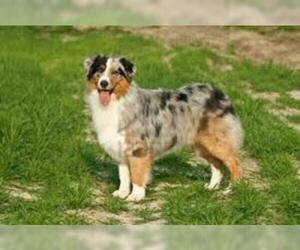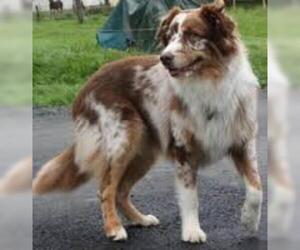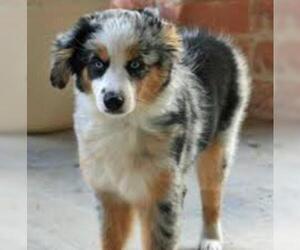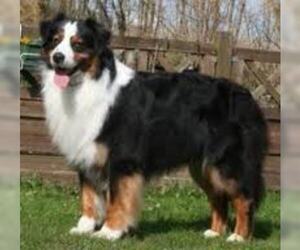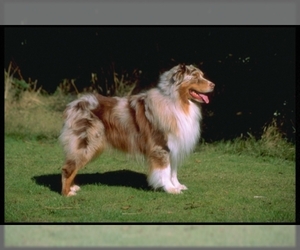
All about Australian Shepherd dog breed
A.K.A. :Aussie, Little Blue Dog, Spanish Shepherd, Pastor Vasco, New Mexican Shepherd, California Shepherd, American Shepherd, New Mexican Sheepdog, California Sheepdog, American Sheepdog, Australian Sheepdog
Size
Grooming requirements
Exercise requirements
Good with other dogs
Watchdog ability
Energetic
Training requirements
Playful
Affectionate
Good with other pets
Good with children
Good with strangers
Winter
Summer
Healthiness
Protective
Life Span
| Pure Breeds | Member |
| Breeds A - Z | A |
| Breeds by Group | Herding |
| Breeds by Trait | Good With Kids High Stamina Dog Breeds Smartest Dog Breeds |
| Overview: | The Australian Shepherd, despite its name, actually originated in the western United States during the 19th century, bred primarily for herding livestock on ranches. These striking dogs are medium-sized with a sturdy build, often sporting captivating merle coats (blue or red) and piercing blue, amber, or marbled eyes, sometimes with two different colors (heterochromia). Known for their exceptional intelligence and high energy, Aussies possess a strong work drive and thrive on having a "job" to do, whether it's agility, obedience, or extensive exercise. Their temperament is generally loyal, affectionate, and good-natured with their families, though they can be reserved with strangers. Due to their high exercise requirements and need for mental stimulation, they are best suited for active families or individuals with ample outdoor space and a commitment to training; apartment living is generally not ideal. Potential owners should also be aware of common health concerns like hip and elbow dysplasia and certain eye conditions, including Collie Eye Anomaly (CEA) and Progressive Retinal Atrophy (PRA). |
F.A.Q.
All You Need to Know About the Australian Shepherd BreedThe Australian Shepherd, often called an "Aussie," is a highly intelligent and versatile herding dog, despite its misleading name; the breed actually originated in the American West. Known for their striking beauty, Aussies possess a medium build, a captivating gaze often with mesmerizing heterochromia (different colored eyes), and a stunning coat that can be merle, black, red, or tricolor. Their temperament is generally outgoing, loyal, and energetic, making them excellent companions for active families. However, their high energy levels and strong work drive mean they are not suitable for apartment living and require extensive daily exercise and mental stimulation to prevent boredom and destructive behaviors. Grooming involves regular brushing, especially during shedding seasons, to maintain their medium-length double coat. While generally healthy, potential owners should be aware of common breed-specific health concerns like hip and elbow dysplasia, certain eye conditions, and drug sensitivities (MDR1 gene mutation). The Australian Shepherd thrives in environments where they have a "job" to do, whether it's herding, agility, or obedience training.
Australian Shepherd Weight: Adult Australian Shepherds typically weigh between 40 and 65 pounds. Males are generally on the higher end of this range, averaging 50-65 pounds, while females usually fall between 40-55 pounds. This average size represents a healthy weight for Australian Shepherd, reflecting the breed's medium build and active nature. When considering an Australian Shepherd, understanding their average weight and typical size helps ensure they are growing appropriately and maintaining a healthy weight for their breed.
Wondering about the Australian Shepherd height or how tall is a Australian Shepherd? This active and intelligent breed typically falls within a consistent range, making them a medium-sized dog.
The average height of an Australian Shepherd, measured at the shoulder (or withers), is usually between 18 to 23 inches. Here's a breakdown:- Males: Generally stand a bit taller, ranging from 20 to 23 inches.
- Females: Are typically slightly smaller, usually measuring between 18 to 21 inches.
The Australian Shepherd is known for its beautiful and diverse coat colors. The AKC recognized Australian Shepherd colors are Black, Red, Blue Merle, and Red Merle, all of which can have or not have white markings and/or copper points.Blue Merle is a stunning pattern where patches of black are diluted to a grey-blue, creating a mottled effect. Red Merle is similar, with red patches diluted to a lighter liver or reddish-brown.Beyond these core colors, you might encounter other Australian Shepherd colors, though they are not officially recognized by major kennel clubs like the AKC for show purposes. These include Dilutes such as Lilac (a diluted red) and Slate (a diluted black), often appearing with lighter eye colors. Yellow or Cream Aussies are also seen, sometimes mistaken for a very light red.Rare coat types and exotic Australian Shepherd variations include Sable, which features individual hairs with bands of color, giving a multi-tonal look. While visually striking, a truly solid White Australian Shepherd can indicate a genetic issue, particularly with merle to merle breedings, and is not desirable. Brindle is another rare pattern, characterized by stripes or streaks of color, and while present in some lines, it's not a standard recognized pattern for the breed.When considering Australian Shepherd colors, remember that pricing can vary based on the rarity and demand for specific coat types, with merles often commanding higher prices due to their unique patterns. Always prioritize health and temperament over color when choosing your Australian Shepherd.
The Australian Shepherd personality is characterized by intelligence, a strong work ethic, and unwavering loyalty. Known for their friendly and outgoing nature, Aussies are generally sociable with new people once they've assessed the situation. Their loyalty to their family is paramount, making them excellent companions. While adaptable, their high energy and need for mental stimulation mean they are generally not well-suited for apartment living unless their owners are committed to extensive daily exercise and enrichment. They are typically good with children, especially when raised with them and properly socialized, often displaying a patient and playful demeanor. Similarly, their temperament of Australian Shepherd allows them to coexist well with other pets, particularly if introduced early and managed appropriately, though their herding instinct may occasionally manifest with smaller, faster-moving animals. They thrive on having a "job" to do, whether it's dog sports, farm work, or simply being an active family member.
The Australian Shepherd temperament is generally described as intelligent, active, and eager to please, making them excellent companion dogs. They are known for their loyalty and forming strong bonds with their families. While generally friendly, they can be reserved or a bit wary with strangers initially, requiring proper socialization to build their sociability.
Aussies are very personable dogs with their families, often described as affectionate and playful. They are good with well-behaved children they’ve been raised with, but their herding instincts might lead them to "herd" young children, so supervision is key. Similarly, with other pets, early socialization is important, and they can coexist peacefully, especially if raised together. Apartment living is generally not ideal for this high-energy breed. They thrive in homes with secure yards and owners committed to daily exercise and mental stimulation. Without sufficient outlets, they can become bored and destructive. Regarding their personality traits, Australian Shepherds are intelligent and quick learners, but they can exhibit a degree of stubbornness, especially if they don't understand the purpose of a command or if they’re testing boundaries. They are also quite sensitive to their owner's tone and mood, responding best to positive reinforcement training methods. They thrive on having a "job" to do, whether it's herding, agility, or just being an active participant in family life.Australian Shepherd Care: Daily Maintenance & Health Tips
Australian Shepherd care involves regular attention to their moderate grooming needs, ensuring adequate exercise, and a balanced diet. This is a low-energy dog breed – kidding! Australian Shepherds are intelligent and active, requiring significant daily physical and mental stimulation.Grooming: Expect moderate grooming for their double coat. Brush weekly, or more often during shedding season (twice a year) to prevent matting and manage loose hair. Regular nail trims are essential. While not brachycephalic, their ears should be checked weekly for cleanliness and signs of infection. They do not have wrinkles requiring special cleaning.Exercise: As a high-energy, working breed, how to care for an Australian Shepherd includes providing at least 1-2 hours of vigorous exercise daily. This can involve long walks, runs, fetch, agility, or herding activities. Mental stimulation through training and puzzle toys is equally important to prevent boredom and destructive behaviors.Dietary Considerations: Feed a high-quality, balanced dog food appropriate for their age, activity level, and size. Monitor calorie intake closely as they can be prone to weight gain. Avoid overfeeding and limit treats. Weight management for Australian Shepherds is crucial to prevent joint issues and other health problems.Climate Sensitivity: Australian Shepherds have a thick double coat that provides insulation. They tolerate cold well but can overheat in hot, humid weather. Provide ample shade and fresh water during warmer months and avoid strenuous exercise during the hottest parts of the day.Common Health Concerns: Be aware of potential health tips for Australian Shepherd breeds. They are generally healthy but can be prone to certain conditions. Regular veterinary check-ups are vital for early detection and prevention. Skin issues in Australian Shepherds can arise from allergies or environmental factors; consult your vet for persistent scratching or irritations. Dental care for Australian Shepherds is paramount; regular brushing and professional cleanings help prevent periodontal disease. Other concerns can include hip and elbow dysplasia, eye conditions (such as Collie Eye Anomaly), and epilepsy.How Active Are Australian Shepherds?The Australian Shepherd activity level is high, making them a very energetic and intelligent breed. These dogs thrive on purpose and require significant daily exercise needs to be happy and well-adjusted. Typically, they need at least 1-2 hours of vigorous activity daily, which can include brisk walks, jogging, hiking, fetching, or engaging in dog sports like agility, flyball, or disc dog. Their herding instincts mean they love to work and enjoy activities that challenge both their bodies and minds. They balance short bursts of intense energy with periods of rest, but generally, they are always ready for action.Australian Shepherds are suitable for active families who can commit to meeting their substantial exercise and mental stimulation requirements. They are not a good match for low-energy households or individuals seeking a sedentary companion, as boredom and pent-up energy can lead to destructive behaviors. While highly athletic, it's important to note that Australian Shepherds are NOT brachycephalic (short-nosed). This means they generally do not have the breathing limitations associated with brachycephalic breeds, allowing them to participate in strenuous activities without the same heat sensitivity or respiratory distress. This makes them excellent partners for outdoor adventures and active lifestyles.
Breed Breakdown: What Experts Say About the Australian Shepherd
I would rate the Australian Shepherd's "Size" trait a 6 out of 10.Australian Shepherds are considered a medium-sized breed. Their average height typically ranges from 18 to 23 inches at the shoulder, and their weight generally falls between 40 and 65 pounds. They possess a sturdy, well-muscled body structure, indicative of their working heritage. While they are clearly not small lapdogs, they are also far from the giant breeds like Great Danes or Mastiffs. When compared to other companion dogs, they are noticeably larger than Beagles or French Bulldogs but significantly smaller than Retrievers or German Shepherds. This makes them a comfortable mid-range dog in terms of physical dimensions.Due to their medium size and high energy levels, Australian Shepherds are generally not ideally suited for apartment living unless their owners are committed to providing extensive daily exercise and mental stimulation outside the apartment. Their active nature and need for space to run and play make them much better suited for households with space constraints that can provide a decent-sized yard or regular access to open areas for exercise. For travel, their size is manageable for most cars and crates, but their energy means they'll likely require frequent stops and opportunities to stretch their legs.
I would rate the Australian Shepherd's grooming requirements at a 7.While not as demanding as some long-haired breeds, they are far from low-maintenance. Their double coat, consisting of a dense undercoat and a longer, water-resistant outer coat, requires regular attention. They are moderate to heavy shedders, particularly during seasonal changes, necessitating frequent brushing (at least 2-3 times a week, daily during shedding seasons) to prevent mats and tangles, especially behind the ears, in the armpits, and on the "feathers" of their legs and tail. This brushing helps manage the shedding and keeps their coat healthy. Bathing needs are moderate, typically every 4-6 weeks or as needed, but proper drying is crucial to prevent skin issues due to their thick coat. They generally don't have skin folds, but ear cleaning is important to prevent infections, especially if they are active outdoors. Nail trimming is a regular requirement, usually every 2-4 weeks, as long nails can cause discomfort and gait problems. While not particularly susceptible to unique skin issues, their thick coat can hide problems if not regularly groomed and inspected. Compared to other companion dogs, they definitely require more frequent and thorough grooming to maintain their coat health and prevent issues, making them more of a "moderate-to-high" maintenance breed in terms of grooming.
I would rate the Australian Shepherd's "Exercise Requirements" at a 9.Australian Shepherds possess extremely high physical and mental energy levels, demanding significant and consistent exercise to remain healthy and well-behaved. They are built for sustained movement and thrive on vigorous activity. Daily walks are insufficient; they require structured routines that include at least 60-90 minutes of high-intensity exercise, often broken into multiple sessions. This can encompass activities like running, hiking, swimming, advanced obedience, herding, or dog sports such as agility and flyball. Their intelligence also necessitates mental stimulation alongside physical exertion, meaning passive activities like simply being in a yard won't cut it. Without adequate outlets for their energy, Australian Shepherds can become bored, destructive, and develop behavioral issues. Their respiratory systems are robust, and they excel at enduring long periods of strenuous activity, unlike brachycephalic breeds. They are not a breed that thrives with minimal activity; rather, they require consistent, challenging routines to stay physically fit and mentally engaged.
I would rate the Australian Shepherd's "Watchdog Ability" at a 7 out of 10.Australian Shepherds are highly intelligent and observant dogs, making them naturally alert to their surroundings. They are quick to notice anything out of the ordinary, whether it's an unfamiliar sound, a car pulling up, or a person approaching the house. This alertness often manifests as a distinctive "alert bark" – a series of barks designed to notify their family of the perceived change. While not typically aggressive, their territorial instincts are present; they are protective of their home and family. They will often position themselves between their family and a perceived threat, and their watchful demeanor can certainly act as a deterrent. They are not overly prone to nuisance barking, but they are certainly not silent and will use their voice to signal a perceived intrusion. They are very capable of providing meaningful early warnings in a home environment and are not passive companions in this regard. Their willingness to deter is more about vocalization and presence than physical confrontation, but their strong bond with their family makes them highly reliable in raising an alarm.
I would rate the "Good with Other Dogs" trait of the Australian Shepherd breed a 7 out of 10.Australian Shepherds generally possess a good temperament and, with proper socialization from a young age, can be highly compatible with other dogs. They are intelligent and often enjoy canine companionship, especially for play and exercise, thriving in multi-dog households where they have established relationships. However, their strong herding instincts can sometimes manifest as "herding" other dogs, which, while not aggressive, can be perceived as pushy or overbearing by some canines. They can also be protective of their "flock" (their human family and home), requiring careful introductions to unfamiliar dogs in their territory. While generally not prone to outright aggression, their intelligence and tendency to observe can sometimes lead to a more reserved or watchful demeanor around new dogs rather than immediate boisterous play. Their high energy levels mean they are best matched with dogs that can keep up or with owners who can manage their interactions effectively. They benefit greatly from continued socialization throughout their lives to ensure peaceful coexistence and to temper any potential for dominance or resource guarding that might emerge without proper guidance.
I would rate the Australian Shepherd's "Energetic" trait a 9 out of 10.Australian Shepherds are an incredibly high-energy breed, originally developed for demanding herding work. Their typical activity level is intense; they are not content with a simple stroll around the block. They possess remarkable endurance, capable of working for hours on end, and their playfulness is boundless, often initiating games and needing constant engagement. Their need for physical stimulation is paramount; without sufficient exercise, they can become destructive, anxious, and prone to behavioral issues. They excel in and absolutely require participation in outdoor and athletic activities such as agility, flyball, disc dog, hiking, and long runs. Compared to most other companion dogs, they are naturally and profoundly active, often described as having an "off" switch that's rarely engaged.It's important to note that while they are energetic, the Australian Shepherd breed is not brachycephalic. They have a standard muzzle length, which means their anatomy does not negatively affect their stamina and exercise tolerance in the way it would for a brachycephalic breed like a Bulldog or Pug. This allows them to effectively regulate their body temperature and breathe freely during strenuous activity, further contributing to their impressive endurance and high energy levels.
I'd rate the Australian Shepherd's "Training Requirements" at a 7.While incredibly intelligent and eager to please, earning them high marks for their ability to learn quickly and their responsiveness to commands, their high energy levels and strong herding instincts can manifest as stubbornness if not properly channeled. They have excellent attention spans when engaged, but without consistent mental and physical stimulation, they can become easily bored and destructive, which then translates into training challenges. They absolutely thrive on consistency and positive reinforcement, and while they are not inherently difficult to train, their demanding need for structure, purpose, and continued engagement means they are not generally considered beginner-friendly. First-time dog owners might find their intensity and intelligence overwhelming without dedicated effort and a clear understanding of their breed specific needs. Experienced handling and structured routines are highly beneficial to ensure they develop into well-behaved and happy companions.
I would rate the Australian Shepherd's "Playful" trait a solid 9 out of 10.Australian Shepherds are incredibly spirited and possess a boundless enthusiasm for life and interaction. They thrive on engaging in games, whether it's a vigorous session of fetch, a stimulating puzzle toy, or a good old-fashioned wrestle. Their typical activity level is very high, and this energy often manifests in their desire to initiate play and seek attention from their owners. They respond to toys and playtime with an almost child-like glee, often exhibiting exuberant body language and a relentless drive to continue the fun. Compared to many other companion dogs, Aussies are decidedly on the naturally spirited side, rarely being described as laid-back or content with mere passive companionship. Their intelligence also plays a role, as they often enjoy games that challenge their minds as much as their bodies, making playtime a truly engaging experience for both dog and owner.
I'd rate the "Affectionate" trait of the Australian Shepherd breed a 9 out of 10.Australian Shepherds are generally incredibly loving and people-oriented dogs. They have a strong desire for human companionship and often form deep bonds with their families. While they might not be the most incessant lap dogs compared to some toy breeds, they are certainly prone to physical closeness, enjoying leaning against their owners, resting their heads on laps, and readily accepting cuddles. Their loyalty is unwavering, and they are highly sensitive to the emotions of their owners, often acting as furry emotional support systems. This sensitivity, combined with their strong desire to be involved, means they typically follow family members around the house, always wanting to be in the same room. They thrive on affection and consistent interaction, and while intelligent and capable of independent thought, they are far from aloof or independent in the way some other working breeds might be. Their happiness is deeply intertwined with their human connections.
I would rate the Australian Shepherd's "Good with Other Pets" trait as a 7 out of 10.Australian Shepherds generally possess a good temperament that can make them compatible with other pets, but it's not a universal given and often requires significant effort. They are intelligent, trainable, and eager to please, which works in their favor. With proper socialization from a young age, many Aussies can form strong bonds with other dogs and even cats. Their herding instinct, while sometimes leading to "nipping" at other pets' heels to move them, can also translate into a protective or watchful demeanor rather than outright aggression.However, their strong prey drive, though typically less intense than some sight hound breeds, can still be a factor, particularly with smaller, fast-moving animals like cats or rabbits. Resource guarding, while not inherently stronger in Aussies than in many other breeds, is a possibility if not managed through training and clear boundaries. Early and consistent socialization is absolutely crucial; an unsocialized Aussie may be more prone to reactivity or fear-based aggression towards unfamiliar animals. They thrive on having a "job" and a clear hierarchy, and in a multi-pet household, this means the owner needs to establish themselves as the leader to prevent potential scuffles over resources or attention. While naturally sociable with their "pack," this doesn't automatically extend to all animals without deliberate guidance and supervision, especially in the initial stages of integration. They are adaptable, but successful coexistence heavily relies on responsible ownership and proactive training.
Rating the "Good with Children" trait of the Australian Shepherd breed on a scale from 1 to 10, I would give them a 7.Australian Shepherds can be wonderful companions for families with children, displaying a good degree of patience and playfulness. They are energetic and love to participate in activities, which makes them great partners for active kids who enjoy playing fetch or running around. Their intelligence often translates into a quick understanding of household dynamics and a willingness to engage. However, their herding instincts, while not aggressive, can manifest as nipping at heels or attempting to "herd" children, especially very young ones. This requires consistent training and supervision to redirect these natural behaviors into appropriate play. While generally affectionate with their own family, they can be somewhat reserved with strangers. Their tolerance for noise and handling is generally good, especially if socialized from a young age, but they might become overstimulated if not given enough mental and physical exercise. They aren't naturally gentle in the sense of being a soft, quiet presence; rather, their gentleness is often cultivated through proper training and an understanding of their energy levels. To truly thrive in a family setting with children, especially younger ones, an Australian Shepherd requires a committed owner who can provide adequate exercise, consistent training, and supervision to ensure positive interactions for both the dog and the children.
I would rate the Australian Shepherd's "Good with Strangers" trait a 6 out of 10.While not inherently unfriendly, Australian Shepherds are typically more reserved than some other breeds when meeting unfamiliar people. They are often described as having a "wait-and-see" attitude; they'll observe a stranger before deciding if they're worthy of their trust and attention. This isn't necessarily shyness, but rather a characteristic of their intelligent and watchful nature. They aren't prone to aggressive unfriendliness unless poorly socialized, but they are also not usually the type to immediately bound up to a new person for pets and greetings like a Golden Retriever might. They do possess a moderate guarding instinct, which can manifest as barking at new arrivals or maintaining a watchful distance, especially if they perceive a threat to their family or territory. However, with consistent and early socialization, Australian Shepherds can become quite comfortable and politely welcoming in public or guest-filled environments. Without proper exposure, they can become more prone to reserved or even wary behavior around strangers. Therefore, their comfort with unfamiliar adults often requires intentional training and positive experiences rather than being a purely natural outgoing trait.
I would rate the Australian Shepherd's "Winter" tolerance at a 7.While not possessing the extreme cold-weather adaptations of breeds like the Siberian Husky, Australian Shepherds are remarkably resilient to winter conditions. Their dense double coat, consisting of a weather-resistant outer coat and a soft, insulating undercoat, provides significant protection against cold temperatures. They are medium-sized dogs with an athletic build, which contributes to a good metabolic rate for generating body heat, and they typically carry a healthy layer of body fat that adds to their insulation. Their mesocephalic (proportionate) skull shape means they don't suffer from respiratory issues that can exacerbate cold sensitivity, unlike brachycephalic breeds. This breed generally loves outdoor activity and can happily enjoy playing in the snow for extended periods, even in moderately cold climates, without significant risk of hypothermia under normal circumstances.However, they are not immune to the cold. In very extreme, sub-zero temperatures, or during prolonged exposure in icy or wet conditions, even an Aussie will be susceptible to hypothermia. While they don't require the specialized care of a toy breed, compared to some other companion dogs, they will appreciate a warm, sheltered space to retreat to after outdoor play. In extremely harsh winter environments, owners should be mindful of their duration outdoors, provide extra warmth if stationary for long periods, and ensure their paws are protected from ice and salt. They generally don't need sweaters or coats for everyday walks in most winter climates, but very old, very young, or sick individuals might benefit from extra warmth.
I would rate the Australian Shepherd's "Summer" tolerance at a 4.While not as sensitive as brachycephalic breeds, Australian Shepherds are a double-coated, active breed prone to overheating. Their thick coats, designed to protect against both cold and heat, can still trap a significant amount of warmth, making heat regulation challenging in high temperatures. They are not brachycephalic, which is a positive, but their high energy levels and desire to work mean they are more likely to overexert themselves in the heat. They are at a moderate to high risk of heatstroke if not properly managed during hot weather, especially during exercise. Recommended outdoor activity levels should be significantly curtailed during peak summer heat, and walks or playtime should be restricted to early mornings or late evenings. They definitely require special care in summer months compared to many other companion dogs. Owners should be vigilant about providing ample shade, fresh water, and cool indoor environments. Air conditioning or fans are often necessary to ensure their comfort and safety during heat waves, especially if they are left alone for extended periods. Unlike breeds with thin coats or less drive, an Aussie's inherent desire to be active can lead them to push past their heat limits, necessitating careful human intervention.
I would rate the Australian Shepherd's "Healthiness" trait as an 8 out of 10.Australian Shepherds are generally considered a robust and resilient breed with a good life expectancy, typically ranging from 12 to 15 years. They are not prone to the severe breathing difficulties seen in brachycephalic breeds, nor are they as delicate or high-maintenance as some toy breeds. However, like many purebred dogs, they do have genetic predispositions to certain health issues that prevent a perfect score. Hip and elbow dysplasia are common concerns, as is a genetic mutation called the MDR1 gene, which can cause sensitivity to certain medications. Eye conditions such as Collie Eye Anomaly (CEA) and progressive retinal atrophy (PRA) are also found within the breed. Responsible breeding practices, including genetic testing of parent dogs, have significantly reduced the prevalence of these hereditary conditions. With proper nutrition, regular exercise, and routine preventive veterinary care, most Australian Shepherds lead long and healthy lives. They are not considered a high-maintenance breed in terms of inherent health issues, but their active nature and intelligent minds do require dedicated owners to provide adequate physical and mental stimulation.
I would rate the Australian Shepherd's "Protective" trait at a 7 out of 10.Australian Shepherds are inherently alert and observant, stemming from their herding background. They are highly loyal to their families and can be quite territorial, readily alerting their owners to anything unusual, including strangers approaching their property. This makes them excellent watchdogs; they will bark to signal a perceived threat. However, their reaction to strangers varies. While they might be reserved or wary at first, their primary instinct isn't typically aggressive protection in a physical sense. They are more likely to deter through their vocalizations and presence rather than engaging in a direct physical confrontation. While their devotion to their owners is strong, they are generally not considered true "guard dogs" in the traditional sense, meaning they aren't bred or typically inclined to physically attack an intruder. They are more of an intelligent companion dog capable of offering meaningful *alerting* and a strong deterrent presence in a household setting, making potential intruders think twice. They will certainly protect their family through their vigilance and warnings, but their protective instincts are rooted more in their herding drive to keep their "flock" (family) safe and accounted for, rather than an aggressive defense mechanism.
I would rate the Australian Shepherd's "Life Span" trait an 8 out of 10.Australian Shepherds are generally considered a long-lived breed compared to many other medium to large-sized dogs. Their average life expectancy typically falls between 12 and 15 years, with many individuals living well into their late teens. While they do have some genetic predispositions to certain health issues like hip and elbow dysplasia, eye anomalies (like Collie Eye Anomaly and Progressive Retinal Atrophy), and some forms of cancer, responsible breeding practices focused on health testing significantly mitigate the risk of these conditions. Furthermore, their active nature and need for mental stimulation contribute to a healthy lifestyle when provided with adequate exercise and a balanced diet. With good care, regular veterinary check-ups, and a bit of luck, an Australian Shepherd has an excellent chance of enjoying a long and vibrant life.
Australian Shepherd Puppies for saleSee all puppies for sale
Australian Shepherd Dogs for adoptionSee all dogs for adoption
Australian Shepherd BreedersSee all breeders
Similar Dog Breeds for Australian Shepherd
Breed Mixes of Australian Shepherd
Quick Breed Selector 0 - not important, 1 - smallest, 10 - largest
Variants & Mistakes :Austrailian Shepherd, Australian Shephard, Austalian Shepherd, Australian Shepard, Aussy Shepherd, Aussie Shephard, Australin Shepherd, Australian Sherpherd, Australian Sheperd, Austrailan Shepard, Australian Sheppherd, Austrilian Shepherd, Austrailian Sheperd, Australian Sheepherd, Australien Shepherd, Aussy Shephard, Austalian Shepard, Austrain Shepherd, Australain Shepherd, Austrailian Shepphard, Australien Shepard, Austrailan Shephard, Austrilian Shepard, Austrailian Sherpherd, Australian Shepphard, Austrailian Sheepherd, Austrilian Shephard, Austalian Sheperd, Austrain Shepard, Australian Shepperd, Australain Shepard
